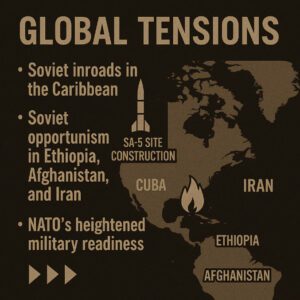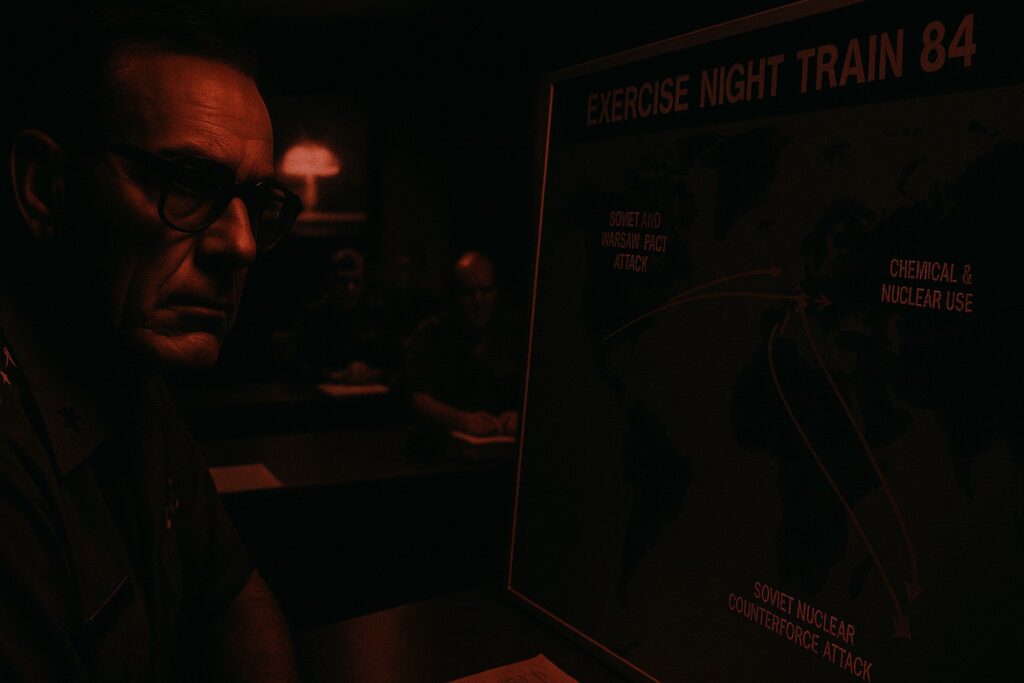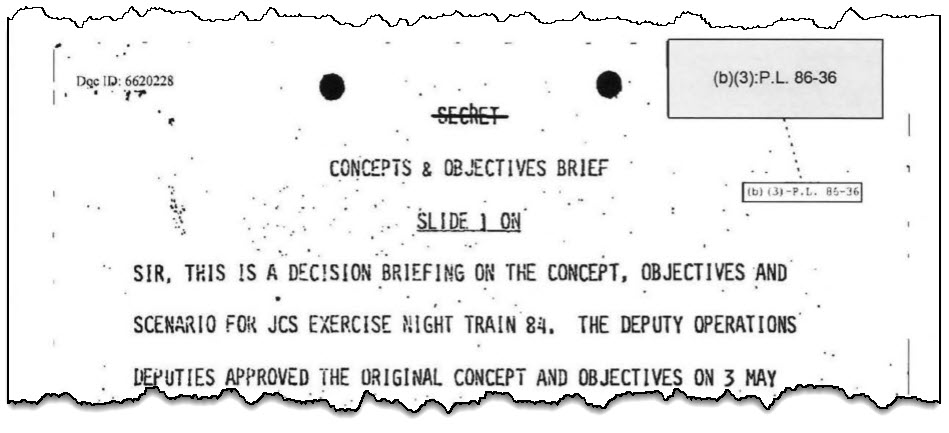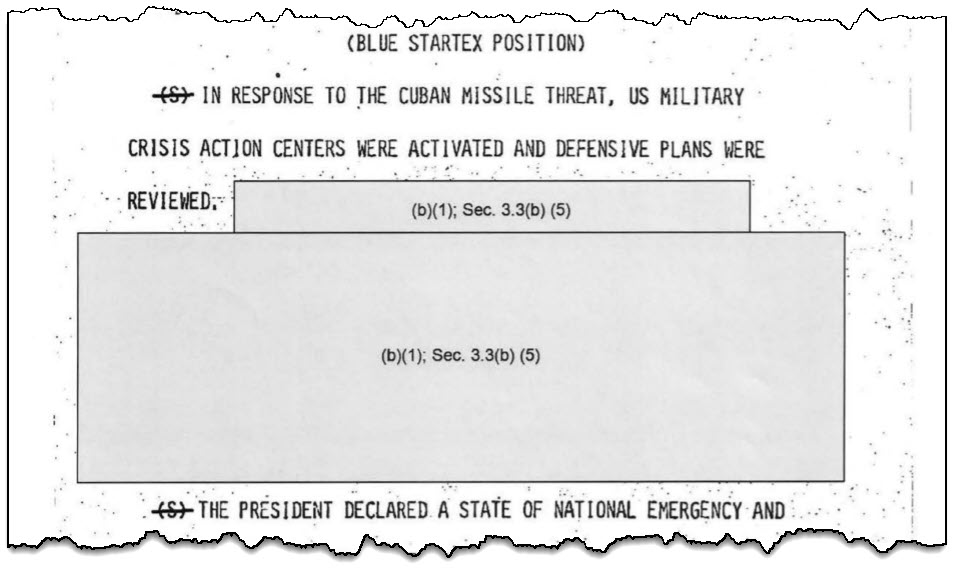The Department of Defense (DoD) has released, through a Freedom of Information Act (FOIA) request filed by The Black Vault, a detailed briefing document outlining the classified scenario for “Exercise NIGHT TRAIN 84.” The document, which appears not to have been publicly released prior to this, provides an in-depth look at Cold War-era planning for nuclear conflict and the associated military and civil defense operations.
According to the document, NIGHT TRAIN 84 was designed as a major biennial nuclear war exercise that included elements from previous exercises such as “GLOBAL SHIELD,” “AMALGAM CHIEF,” and FEMA’s “REX 84 ALPHA.” The exercise aimed to simulate coordinated responses to a global nuclear conflict, with live flying and the use of strategic weapon systems incorporated into the exercise play. The scenario was directly shaped by Cold War tensions and modeled on large-scale Soviet exercises reviewed in June 1982.
“The exercise is designed with two four-day phases,” the document states, “on the pre and trans-attack period… A 24-hour administrative break will simulate 15 days of survival and recovery activity. Phase II will begin on Day 6 of the exercise and will concentrate on activities in the post-nuclear attack period.”
A primary objective was to test U.S. continuity of government plans following a nuclear exchange, as well as strategic and tactical military responses. “National participation is anticipated because of the desire to evaluate post-nuclear attack continuity of government plans,” the briefing notes.

The simulated scenario begins with escalating global tensions, including Soviet inroads in the Caribbean, discovery of Soviet SA-5 missile site construction in Cuba, and Soviet opportunism in Ethiopia, Afghanistan, and Iran. The exercise projects events such as open civil war in Iran, increased Soviet military aid and presence in various regions, and NATO’s heightened military readiness in response to Soviet exercises perceived as cover for mobilization.
By 5 April 1984, the exercise posits that “Soviet and Warsaw Pact forces attacked in Central Europe and Turkish Thrace,” with chemical and nuclear weapons employed on 6 April in an attempt to break NATO resistance. The scenario culminates in “Soviet nuclear counterforce attacks against the United States and follow-on theater nuclear strikes on NATO” on 8 April.
In the wake of these simulated attacks, the United States shifted focus to survival and recovery operations during a compressed 15-day period. The exercise outlined that “unified and specified commands will operate at reduced strength from alternate command locations during this phase and will concentrate on reconstitution of their commands and redirection of their forces.” A major emphasis was placed on ensuring coordination between surviving national command authorities (NCA), reconstituted federal agencies, and state governments, with the Commander-in-Chief Readiness Command (CINCRED) playing a central role in civil defense support. This phase was described as “a first step toward defining, developing and evaluating procedures for coping with events which might occur in the aftermath of nuclear war,” highlighting the complexities of maintaining command connectivity and stabilizing the nation following a large-scale nuclear strike.
Meanwhile, the document describes the grim aftermath facing the Soviet Union. “While most of the Soviet and elements of Warsaw Pact leadership survived the U.S. retaliatory strike, they were not able to reconstitute their strategic arsenal as quickly as had been expected… Restoration of key production and services was inhibited by popular unwillingness to return to contaminated areas.”
The exercise also envisioned significant civil unrest within the Soviet bloc and a turn toward diplomatic resolution. “Faced with these problems, Soviet leaders began to seek a political solution to the crisis,” with both sides agreeing on a ceasefire in the European theater after 15 days.
Throughout, the document emphasizes the importance of testing the interaction between surviving national command authorities (NCA), reconstituted government agencies, and state governments. The scenario aimed to “provide study and better understanding of the complex issues involved in the trans- and post-nuclear attack periods.”
Portions of the document remain redacted, withheld under FOIA exemptions including 5 U.S.C. § 552(b)(1) for information classified in the interest of national security and 5 U.S.C. § 552(b)(3) under 50 U.S.C. 3605, protecting NSA functions and information.
The release of this document comes at a time when global tensions echo some of the very scenarios envisioned in NIGHT TRAIN 84. Today, Iran remains a focal point of international security concerns, with ongoing disputes over its nuclear program, regional influence, and relations with the United States and its allies. The fictional civil war and foreign interventions in Iran portrayed in the exercise underscore the enduring strategic significance of the region, as well as the risks posed by instability there.
Moreover, the exercise’s emphasis on rapid escalation, chemical and nuclear weapons use, and the struggle to maintain continuity of government after a large-scale nuclear exchange serves as a stark reminder of the catastrophic consequences that could arise from modern conflicts spiraling out of control. As nuclear-armed states continue to navigate strained relations, the lessons and planning embedded in Cold War exercises like NIGHT TRAIN 84 remain relevant, highlighting the need for diplomacy, crisis management, and updated continuity plans in an increasingly unpredictable world.
###
Document Archive
 Exercise Night Train 84 Briefing, August 1983 [24 Pages, 5.5MB]
Exercise Night Train 84 Briefing, August 1983 [24 Pages, 5.5MB]
 Loading...
Loading...
Follow The Black Vault on Social Media:



